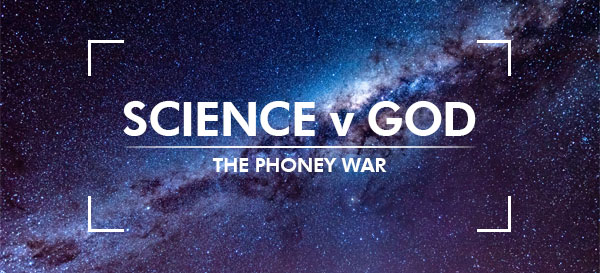© 2020 Nick Goffin / Harvest City Church
The debate around the existence of God, science and evolution often gets bogged down in technical details which are difficult to understand. Dozens upon dozens of books have been written and many hundreds of thousands of words have been expended in order to debate the answer to a question that is fundamentally extremely simple: There are two possible explanations for the universe that surrounds us with all of its glory and complexity: either it happened by chance, or it happened on purpose. Which one is true?
What Science Actually Is
Atheists will often talk about science as if it is this vast, incredible ‘thing’, unlocking deep truths about the universe. Richard Dawkins talks like this, in reverential, almost religious tones. In reality, science is a method, a way of thinking; nothing more. It is something that people do all the time:
- Step 1 (problem): My potato plants keep disappearing.
- Step 2 (theory): I think badgers are eating them.
- Step 3 (experiment): I stay up at night to watch for them.
- Step 4 (conclusion): Badgers are in fact eating my potato plants.
This might be followed by ‘Step 5 (new problem): I need to stop badgers from eating my potato plants’. It is true that the more advanced forms of science are difficult to do and require specialised training, but this does not mean that there is anything special about scientists. The basic method described above is as useful to nuclear physics as it is to garden vegetable patches. Christians have no need to be intimidated by ‘science’. If you can follow the logic given above, you can do science.
Does science prove God? No. Does science disprove God? Also no. Science does not prove things. What science does is provide a set of evidence that can be interpreted in different ways. To go any further in either direction is an act of faith. The correct question therefore is not whether science proves God’s existence, but whether science provides sufficient evidence to make faith in His existence reasonable, and whether this faith is more reasonable than belief in His non-existence (which is also an act of faith).
The Improbable Earth
Scientists have been keen in their writings to make it seem that humanity—and Earth in general—is nothing special. As science has developed however, it has become increasingly clear that Earth is very special indeed. Star Trek would have us believe that life pops up really easily, with aliens all over the galaxy, but in reality the conditions required for life to exist at all, anywhere, are so utterly, ridiculously specific that the likelihood of it happening by chance even once (on Earth) might as well be zero. Every single thing that has happened to this planet over the course of its long existence had to happen in exactly the right way, at exactly the right time and in exactly the right order for you to be here reading this article right now.
Let’s start with galaxies. The Milky Way is a spiral galaxy, with the stars spread out in long arms from the centre. Spiral-type galaxies represent about half of the total observed galaxies1 and are the only ones that can support life. However not just any spiral galaxy will do. A very specific environment is required for a spiral galaxy to maintain a stable shape. Therefore not only does the Milky Way have to be the correct size and shape itself, but all of the surrounding galaxies also have to be present in the right numbers, the right sizes, shapes and distances away2.
When we look within the Milky Way, we find that the majority of its 100-billion-or-so stars are either too big, too small, too unstable, or in the wrong place for life to ever exist on their planets. Not only is the current location, size and age of the Sun important; so is its history. The Sun had to form close to the centre of the galaxy near lots of large exploding stars in order to collect the necessary heavy elements for complex life. It then had to move to its current position further out so life could actually develop and survive. This migration had to happen in a very specific way to prevent the Solar System from being ripped apart in the process. These events are all highly improbable3, however they all happened.
The requirements for the Solar System itself are also very specific. The arrangement of our planets is actually highly unusual, and every one has to be exactly the size that it is, and in the place that it is, for life to survive. The size, position and density of the asteroid belts, even the size and distance of the moon, are all vitally important and can only have come about through highly specific circumstances4.
Evolution Cannot Create Life
An interesting observation that I made when surveying the scientific literature on the history of life is that evolution is never questioned. Researchers will state that such-and-such a thing evolved (for example, eyes), without asking the obvious question ‘can evolution actually do that?’. Biologists generally prefer to simply state evolution as fact and move on. The uncomfortable truth is that most of the time, the answer to this question is ‘no’.
Firstly, evolution is not creative5. It only has the ability to preserve, modify or destroy (often by modifying) pre-existing structures. The structures themselves are supposedly created at random. They might arise tomorrow, or they might arise in a billion years. They might never arise. Evolutionists just tend to assume that if a given change is needed then it will appear, but there is absolutely no scientific reason to believe that this is true.
In addition to this, the kind of random mutational changes that evolutionists claim are responsible for creating life are actually terrible at creating things, but very good at breaking things6. Evolution generally solves problems in the same way that removing the wheels from my car prevents thieves. The theft problem is solved, but now I can’t drive it. Real-world examples of evolutionary adaption usually involve the loss or reduction of some kind of capability7–9. Creation of new capabilities has rarely been observed, and when it has, it has only been at a very basic level.
Life is also incredibly complex. Each cell in your body is a highly organised protein factory with multiple assembly lines running in parallel, proof-reading devices and multi-layered control systems; the whole thing arguably being more complicated than the body the cell is part of10. Like a skyscraper, this kind of system must be fully planned out from the top down; it cannot evolve in small steps by chance. To suggest that it did is as ridiculous as suggesting that the slow accretion of sticks, rocks and mud that dams a river will somehow eventually evolve into a hydroelectric power station.
Conclusions
Although many scientists like to pretend that we arrived here as a product of random chance, the actual evidence does not bear this out. Although random chance is technically possible, the likelihood of all the required things happening by themselves—all in the right place, at the right time and in the right order—is so low that it can be assumed that it would never actually happen. The fact that it did happen (we are here, after all) shows that the evidence actually points in a different direction, to a supernatural creator who designed everything to happen that way on purpose.
Further to this, claims are made about evolution out of all proportion to its demonstrated capabilities. There is no evidence that evolution can actually create the kinds of creatures that we see in the fossil record, and plenty of evidence that it can’t. Life does not get simpler as it gets smaller, it gets more complicated. The evidence for design is clear.
As science has developed, random chance has steadily become less plausible as an explanation, not more. What we end up with is the conclusion that the existence of a designer fits the scientific facts far better than the accumulation of random chances. However, although science sets us on the path, to learn about God we have to step beyond its borders. We can do so secure in the knowledge that our journey of faith is rooted in factual reality.
References
1. Loveday, J. The APM Bright Galaxy Catalogue. Mon. Not. R. Astron. Soc. 278, 1025–1048 (1996).
2. Lin, L. et al. The Pan-STARRS1 medium-deep survey: The role of galaxy group environment in the star formation rate versus stellar mass relation and quiescent fraction out to z ~ 0.8. Astrophys. J. 782, (2014).
3. Parker, R. J. & Dale, J. E. Did the Solar system form in a sequential triggered star formation event? Mon. Not. R. Astron. Soc. 456, 1066–1072 (2016).
4. Mackenzie, D. The Big Splat, or, How Our Moon Came to Be. (John Wiley & Sons, 2003).
5. Pradeu, T. & Schäfer, K. Homology: The Evolution of Morphological Organisation. in Origination of Organismal Form: Beyond the Gene in Developmental and Evolutionary Biology (eds. Müller, G. B., Newman, S., Newman, S. A. & Schäfer, K.) 332 (MIT Press, 2003).
6. Behe, M. J. The Edge of Evolution: The Search for the Limits of Darwinism. (Simon and Schuster, 2008).
7. Buckley, J. & Bridle, J. R. Loss of adaptive variation during evolutionary responses to climate change. Ecol. Lett. 1316–1325 (2014) doi:10.1111/ele.12340.
8. Thompson, T. Q., Bellinger, M. R., Rourke, S. M. O., Prince, D. J. & Stevenson, A. E. Anthropogenic habitat alteration leads to rapid loss of adaptive variation and restoration potential in wild salmon populations. Proc. Natl. Acad. Sci. 116, 177–186 (2019).
9. Maron, D. F. Under poaching pressure, elephants are evolving to lose their tusks. National Geographic https://www.nationalgeographic.com/animals/2018/11/wildlife-watch-news-tuskless-elephants-behavior-change/.
10. Alberts, B. The Cell as a Collection of Protein Machines: Preparing the Next Generation of Molecular Biologists. Cell 92, 291–294 (1998).












